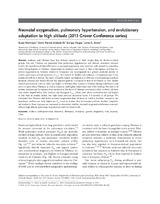Mostrar el registro sencillo del ítem
Neonatal oxygenation, pulmonary hypertension, and evolutionary adaptation to high altitutde (2013 Grover Conference series)
| dc.contributor.author | Niermeyer, Susan | |
| dc.contributor.author | Andrade-M, Mario Patricio | |
| dc.contributor.author | Vargas, Enrique | |
| dc.contributor.author | Moore, Lorna G | |
| dc.date.accessioned | 2016-09-20T16:03:05Z | |
| dc.date.available | 2016-09-20T16:03:05Z | |
| dc.date.issued | 2015-03 | |
| dc.identifier.uri | http://repositorio.umsa.bo/xmlui/handle/123456789/7957 | |
| dc.description.abstract | Abstract. Andeans and Tibetans have less altitude reduction in birth weight than do shorter-resident groups, but only Tibetans are protected from pulmonary hypertension and chronic mountain sickness (CMS). We hypothesized that differences in neonatal oxygenation were involved, with arterial O2 saturation (SaO2) being highest in Tibetans, intermediate in Andeans, and lowest in Han or Europeans, and that improved oxygenation in Andeans relative to Europeans was accompanied by a greater postnatal decline in systolic pulmonary arterial pressures (Ppasys). We studied 41 healthy (36 Andeans, 5 Europeans) and 9 sick infants at 3,600 m in Bolivia. The SaO2 in healthy babies was highest at 6–24 hours of postnatal age and then declined, whereas sick babies showed the opposite pattern. Compared to that of 30 Tibetan or Han infants studied previously at 3,600 m, SaO2 was higher in Tibetans than in Han or Andeans during wakefulness and active or quiet sleep. Tibetans, as well as Andeans, had higher values than Han while feeding. The SaO2’s of healthy Andeans and Europeans were similar and, like those of Tibetans, remained at 85% or above, whereas Han values dipped below 70%. Andean and European Ppasys values were above sea-level norms and higher in sick than in healthy babies, but right heart pressure decreased across 4–6 months in all groups. We concluded that Tibetans had better neonatal oxygenation than Andeans at 3,600 m but that, counter to our hypothesis, neither was SaO2 higher nor Ppa lower in Andean than in European infants. Further, longitudinal studies in these 4 groups are warranted to determine whether neonatal oxygenation influences susceptibility to high-altitude pulmonary hypertension and CMS later in life. | es_ES |
| dc.language.iso | en | es_ES |
| dc.publisher | Pulm Circ | es_ES |
| dc.subject | TRANSICIÓN CARDIOPULMONAR | es_ES |
| dc.subject | ADAPTACIÓN GENÉTICA | es_ES |
| dc.subject | HIPOXIA | es_ES |
| dc.title | Neonatal oxygenation, pulmonary hypertension, and evolutionary adaptation to high altitutde (2013 Grover Conference series) | es_ES |
| dc.type | Article | es_ES |

